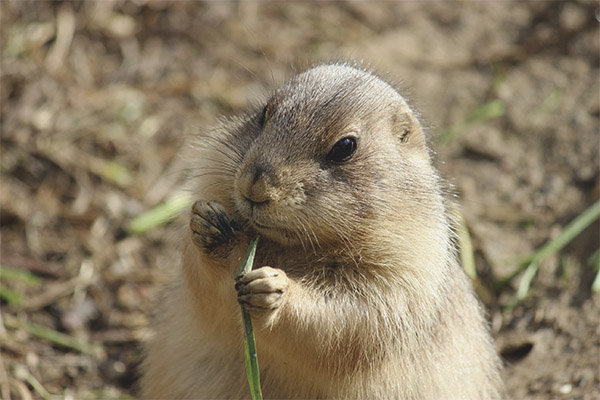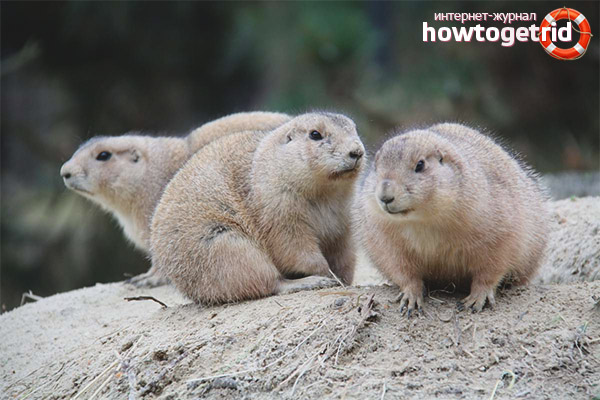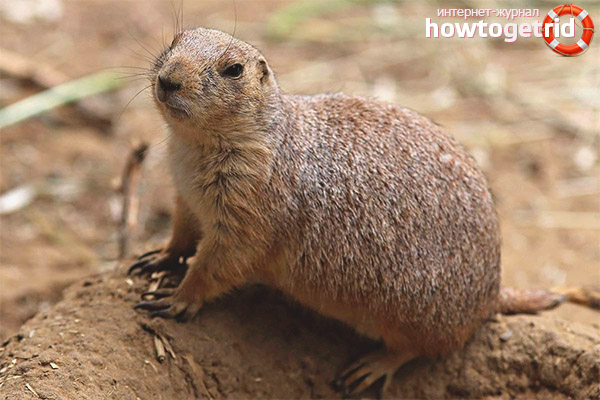The content of the article
If it comes to prairie dogs, it is difficult even to imagine that you will have to face rodents. Outwardly, they resemble a marmot or gopher, but at the same time they are capable of making sounds similar to dogs barking. In the past, these rodents were destroyed on a large scale, and now many of them give birth as pets. This contributes to the fact that their way of life is similar to the human.
Some features and nature of the habitat
Their habitat is the desert and steppe territories of the North American continent and central Mexico. They prefer to be on a dry grassy plain with a nearby pond. But in places where there is wet soil and lowlands, they do not like to be. These rodents can exist in five species.Each of them has its own color coat and the territory of their predominant habitat.
Living in the prairies, they are capable of causing significant damage, which, naturally, is not to the liking of the locals. For this, they disliked these rodents and always subjected to destruction. Horses could be crippled if the foot fell into the hole of a rodent. The same goes for cattle. Before the start of the company for their destruction in nature, there were about a million individuals. Mass destruction has given its results. Today, there is only 2% of the amount that was before. Battered their people pretty.
An adult animal can grow up to 35 cm, and the weight gain up to 2 kg. But in different seasons the animal weighs in different ways. Females are more modest in size. The animals got their name because they are capable of making sounds that look like puppies barking. The prairie dog is a good competitor to any excellent digger. The ability to dig a good burrow is due to the presence of sharp claws on their paws.
The color of the coat varies in a wide range. It is characterized by the most different color, in which you can find gray, brown and dark colors.The abdomen is colored light beige. The head is rounded, and on it are the eyes with a wide statement. Their ears hides thick wool. The body ends with a small and fluffy tail.
Animals can create a maze, the length of which reaches 350 m. Its depth can be 5 meters. By area, it can occupy 1 hectare, and in the territory one can observe the presence of a large number of outlets. Separate labyrinths have up to 50 outputs. On the surface of the animals, a shaft is formed in the form of a ring. This is a kind of protection against flooding. At the same time, he plays the role of a watchtower.
The enemies
These animals have a lot of enemies. They are hunted by a badger, coyote, snake, fox, and other animals that are predators.The attack from above is undertaken by golden eagles and falcons.
Selected moments of lifestyle
For prairie dogs is characterized by its own social hierarchy. The family headed by a male includes up to 20 individuals. In addition to the male, 3-4 females and two-year-old offspring enter the seminal structure. All of them live in a separate "cottage", where even the children's room is allocated for the future offspring. In it, the female gives birth and nurses the cubs. Naturally, the male plays the role of a guard. He is quite skillfully and strongly guarded his home.
Family members do not like strangers. They try to get rid of them in every way. At the same time, they avoid physical measures of influence and only in exceptional cases destroy especially persistent uninvited guests. The community is characterized by a strict distribution of functions. It stands out the builders. They are creating new galleries, and carried out the repair of old buildings. A separate group of guards stand out. Their task is to ensure the safety of the town. Finally, some individuals act as educators. Their functions include teaching the younger generation how to survive.
These rodents are especially gifted animals. They are distinguished by hard work and express communication. They do this by means of sounds resembling a dog barking, which is accompanied by blows of the tail. Scientists compare such communication with the language of dolphins or primates. The rodent, making sounds, not only warns of the threat, but also speaks about who is coming from which side. If something threatens, the animal tries to keep close to the mink or goes deep.
Rodents are most active in the daytime. During the day, they not only work, but also play with the kids and communicate with each other. These animals can even kiss. This happens by touching one another with an open mouth. Relationship relationships differ trustful and caring nature. All such rodents, with the exception of the black-tailed meadow dog, are capable of hibernating. They fall asleep from the end of August and sleep until March, when it gets warmer.
Power type
They mainly feed on the grass that can be found where they live. Food is represented by flowers, leaves, buds and even fresh fruits and nuts.Worms and insects may be present in the diet, although such food is not typical for them.
Rodents are not made to do stocks. Everything is eaten right on the spot. They have no storerooms. Those who did not hibernate, in the winter in the diet use any vegetation that only they fall.
Breeding features
The mating season is in early spring. The female is able to bear offspring up to 32 weeks. Litter consists of 4-7 cubs. It happens once a year. Born baby is deprived of a fur coat and is not able to see. After 6 weeks after birth, the young rodent begins to show signs of independence. He is trying to get out of the hole. During this period, they no longer need breast milk, but switch to plant foods.
Parents in relation to the offspring are expressed concern. They can even leave the kids their own housing, and build a new shelter for themselves. Growing males create a new family. Females can stay with their parents.
In the wild, the life expectancy of these rodents is 5-7 years. At home, they can live much longer, of course, if all the conditions are created for this.Animals are very easy to tame. Accustomed to new conditions, they do not even attempt to escape into the wild.
Rodent care in the home
Many are willing to acquire this animal at home. Not everyone knows at what age it is worth buying a rodent. It is better to buy the animal at this age, when he only stopped eating mother's milk and switched to vegetable food. If you do it earlier than this period, the animal will simply die. Without mother's milk, it will not survive. This is due to the fact that getting the milk of the mother, the animals form a "baby fat". It protects the baby from external factors. If it is not, the animal can simply die from hypothermia. It is better to bring an animal into the house when it turns 2-4 months old.
Care rules
If the animal is small enough, then you need to take care of the food that will suit him. It should be fed whole milk mixed with electrolytes. This is done with the help of a special syringe purchased at the pet store. It is intended for feeding chicks. The injection of milk is carried out very carefully.Avoid getting milk into the cavity of the trachea. They feed only warm milk, and do it every 3 hours.
Pet's dwelling
Whatever the age of the animal, the house still needs it. In any case, it should be spacious. It is impossible to escape from natural habits, therefore, conditions are created in order to enable the rodent to dig a hole. This is ensured by placing in the dwelling a sufficient layer of substrate consisting of sand and earth. Their volumes should be equivalent. If a cage is used as a dwelling, then dry grass is laid on the bottom. But, if the rodent will cope with their needs directly to her, then unpleasant odors can not be avoided. Therefore, there should be a tray under the cage. You can make a special bed for the animal, in which it will sleep. It must be placed in a cage just before bedtime. This animal is considered smart, so the bed will never be a shit.
To avoid being bored, the animal is provided with toys. You can be sure that the animal will use them as intended. But toys should not be soft. For their manufacture requires a dense material.Do not forget that the rodent has a rather sharp teeth. It would be nice to put in the cage branches, snags. The animal will only be happy about it.
To accustom to the toilet is a troublesome task, but it is quite possible to do this. Under the toilet you can select a large cat tray. Inside it poured filler. Cleaning the cage is necessary in the morning. It takes only 5-10 minutes.
In the dwelling it is necessary to maintain the temperature comfortable for the animal. It should be in the range of 19 to 25 degrees. Rodent is a heat-loving animal. It is possible to put a thermovry in a cage.
Hygiene procedures
They are accustomed to water gradually. If you just take and dip the animal into the water, then it will get a lot of stress. Initially, a jet of water from the shower is sent to the limbs, then it rises above and covers the entire body. Water should be avoided in the ears, otherwise they may become inflamed. Then a visit to the vet is unavoidable. After bathing the animal should be thoroughly wiped with a soft towel. Up to 6 months bathing is not carried out. You can simply periodically use wet wipes to wipe the body.
Feeding
Despite the fact that the rodent belongs to exotic animals, it is not picky at all in the diet. It is necessary to feed it with grass, cereals, bulbous plants. In general, food should not be very different from the one that exists in the wild.
Video: prairie dogs (Cynomys)













To send